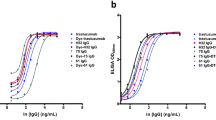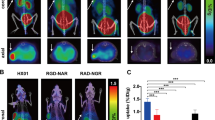Abstract
Ephrin type-A 2 (EphA2) is a transmembrane receptor expressed in epithelial cancers. We report on a phase I dose escalation and biodistribution study of DS-8895a, an anti-EphA2 antibody, in patients with advanced EphA2 positive cancers. DS-8895a was administered at 1, 3, 10 or 20 mg/kg every 2 weeks to determine safety, pharmacokinetics and anti-tumor efficacy. All patients underwent 89Zr trace-labelled infusion of DS-8895a (89Zr-DS-8995a) positron emission tomography imaging to determine the biodistribution of DS-8895a, and correlate findings with EphA2 expression, receptor saturation and response. Nine patients were enrolled on study. Of patients enrolled, seven patients received at least one infusion of DS-8895a: four patients received 1 mg/kg dose (Cohort 1) and three patients received 3 mg/kg dose (Cohort 2). Median age was 67.0 years (range 52—81), majority male (71%), and median number of prior systemic therapies was three (range 0—8). The primary cancer diagnosis was colorectal cancer (two patients) and one patient each had gastric, head and neck, high-grade serous adenocarcinoma, lung, and pancreatic cancers. No dose-limiting toxicities or treatment-related adverse events reported. The best response for the patients in Cohort 1 was stable disease and in Cohort 2 was progressive disease. 89Zr-DS-8895a demonstrated no normal tissue uptake and specific low-grade uptake in most tumours. DS-8895a had limited therapeutic efficacy at doses evaluated and 89Zr-DS-8895a demonstrated low tumour uptake. The biodistribution data from this study were key in halting further development of DS-8895a, highlighting the importance of biodistribution studies in drug development. (Trial registration: ClinicalTrials.gov Identifier NCT02252211).


Similar content being viewed by others
Data availability
All data generated or analysed during this study are included in this published article [and its supplementary information files].
References
Hasegawa J et al (2016) Novel anti-EphA2 antibody, DS-8895a for cancer treatment. Cancer Biol Ther 17(11):1158–1167
Burvenich IJ et al (2016) Molecular imaging and quantitation of EphA2 expression in Xenograft models with 89Zr-DS-8895a. J Nucl Med 57(6):974–980
Easty DJ, Herlyn M, Bennett DC (1995) Abnormal protein tyrosine kinase gene expression during melanoma progression and metastasis. Int J Cancer 60(1):129–136. https://doi.org/10.1002/ijc.2910600119
Nemoto T et al (1997) Overexpression of protein tyrosine kinases in human esophageal cancer. Pathobiology 65(4):195–203. https://doi.org/10.1159/000164123
Rosenberg IM et al (1997) Epithelial cell kinase-B61: an autocrine loop modulating intestinal epithelial migration and barrier function. Am J Physiol 273(4):G824–G832. https://doi.org/10.1152/ajpgi.1997.273.4.G824
Zelinski DP et al (2001) EphA2 overexpression causes tumorigenesis of mammary epithelial cells. Can Res 61(5):2301–2306
Walker-Daniels J et al (1999) Overexpression of the EphA2 tyrosine kinase in prostate cancer. Prostate 41(4):275–280. https://doi.org/10.1002/(sici)1097-0045(19991201)41:4%3c275::aid-pros8%3e3.0.co;2-t
Ciprotti M et al (2015) Phase I imaging and pharmacodynamic trial of CS-1008 in patients with metastatic colorectal cancer. J Clin Oncol 33(24):2609
Shitara K et al (2019) Safety, tolerability, pharmacokinetics, and pharmacodynamics of the afucosylated, humanized anti-EphA2 antibody DS-8895a: a first-in-human phase I dose escalation and dose expansion study in patients with advanced solid tumors. J Immunother Cancer 7(1):219
Eisenhauer EA et al (2009) New response evaluation criteria in solid tumours: revised RECIST guideline (version 1.1). European j cancer 45(2):228–247
Scott AM et al (2020) First clinical study of a pegylated diabody 124 I-labeled PEG-AVP0458 in patients with tumor-associated glycoprotein 72 positive cancers. Theranostics 10(25):11404–11415
Scott AM et al (2005) A phase I trial of humanized monoclonal antibody A33 in patients with colorectal carcinoma: biodistribution, pharmacokinetics, and quantitative tumor uptake. Clin Cancer Res 11(13):4810–4817
Scott AM et al (2007) A phase I clinical trial with monoclonal antibody ch806 targeting transitional state and mutant epidermal growth factor receptors. Proc Natl Acad Sci 104(10):4071–4076
Herbertson RA et al (2014) Targeted chemoradiation in metastatic colorectal cancer: a phase I trial of 131I-huA33 with concurrent capecitabine. J Nucl Med 55(4):534–539
Herbertson RA et al (2009) Phase I Biodistribution and Pharmacokinetic Study of Lewis Y-Targeting Immunoconjugate CMD-193 in Patients with Advanced Epithelial Cancers. Clin Cancer Res 15(21):6709–6715
Stabin MG, Sparks RB, Crowe E (2005) OLINDA/EXM: the second-generation personal computer software for internal dose assessment in nuclear medicine. J Nucl Med 46(6):1023–1027
Valentin J (2007) International Commission on Radiological Protection. The 2007 recommendations of the international commission on radiological protection. Annals of the ICRP, ICRP Publication 103:2–4
Bolch W et al (2016) ICRP publication 133: The ICRP computational framework for internal dose assessment for reference adults: specific absorbed fractions. Ann ICRP 45(2):5–73
Heskamp S et al (2017) 89Zr-immuno-positron emission tomography in oncology: state-of-the-art 89Zr radiochemistry. Bioconjug Chem 28(9):2211–2223
Lamberts LE et al (2015) Antibody positron emission tomography imaging in anticancer drug development. J Clin Oncol 33(13):1491–1504
van de Donk PP et al (2020) Molecular imaging biomarkers for immune checkpoint inhibitor therapy. THERANOSTICS 10(4):1708–1718
Carrasquillo JA et al (2019) Imaging Patients with Metastatic Castration-Resistant Prostate Cancer Using 89Zr-DFO-MSTP2109A Anti-STEAP1 Antibody. J Nucl Med 60(11):1517–1523
Jauw YW et al (2019) Interobserver reproducibility of tumor uptake quantification with 89 Zr-immuno-PET: a multicenter analysis. Eur J Nucl Med Mol Imaging 46(9):1840–1849
Acknowledgements
Not applicable.
Funding
We acknowledge our funding sources including Daiichi-Sankyo for the support of the trial, Operational Infrastructure Support from the Victorian Government and the Clinical Trials Management group at Ludwig Cancer Research (New York), the support of SP (La Trobe University PhD Scholarship) and AMS (NHRMC Investigator Fellowship No. 1177837). This research was also undertaken using the Solid Target Laboratory, an ANSTO-Austin-LICR-ONJCRI Partnership.
Author information
Authors and Affiliations
Contributions
Hui K Gan, Masakatsu Kotsuma. Giorgio Senaldi, Ralph Venhaus and Andrew M. Scott contributed to the study conception and design. Material preparation, data collection and analysis were performed by all authors. The first draft of the manuscript was written by Hui K Gan and all authors commented on previous versions of the manuscript. All authors read and approved the final manuscript.
Corresponding author
Ethics declarations
Ethics approval and consent to participate
This study was approved by the Institutional Ethics Committee (IEC) at Austin Health. Written informed consent was obtained from all patients and all methods were performed in accordance with the protocol-specified guidelines and regulations.
Consent for publication
No identifiable data or material in relation to individual patients is used in this publication. Informed consent was obtained from all individual participants included in the study.
Research involving human participants and/or animals
This study was approved by the Institutional Ethics Committee (IEC) at Austin Health. The study was conducted in accordance with the principles of the Declaration of Helsinki (fourth revision, 1996) and the International Conference on Harmonisation (ICH) Good Clinical Practice (GCP) Guidelines.
Informed consent
Consent to participate; Written informed consent was obtained from all patients and all methods were performed in accordance with the protocol-specified guidelines and regulations. Consent for publication: No identifiable data or material in relation to individual patients is used in this publication. Informed consent was obtained from all individual participants included in the study.
Competing interests
Not applicable. HG received honoraria, travel support and/or research funding from AbbVie, Bristol-Myers Squibb, Eisai, EMD Serono and MSD. SP: received honoraria from AstraZeneca and MSD. NT serves as a consultant to Roche, Amgen, Bristol-Myers Squibb and Eisai Pharmaceuticals. MK and GS are employees of Daiichi Sankyo and may own stock. AMS received research funding and travel support from AbbVie; received research funding from Daiichi-Sankyo, EMD Serono, Merck, Telix, Avid, Celgene, ITM, Adalta; is a consultant and has stock in Life Science Pharmaceuticals, and has stock in Paracrine Therapeutics.
Additional information
Publisher's Note
Springer Nature remains neutral with regard to jurisdictional claims in published maps and institutional affiliations.
Supplementary Information
Below is the link to the electronic supplementary material.
Rights and permissions
About this article
Cite this article
Gan, H.K., Parakh, S., Lee, F.T. et al. A phase 1 safety and bioimaging trial of antibody DS-8895a against EphA2 in patients with advanced or metastatic EphA2 positive cancers. Invest New Drugs 40, 747–755 (2022). https://doi.org/10.1007/s10637-022-01237-3
Received:
Accepted:
Published:
Issue Date:
DOI: https://doi.org/10.1007/s10637-022-01237-3




